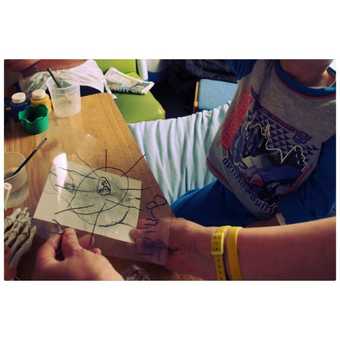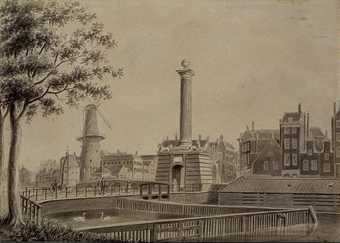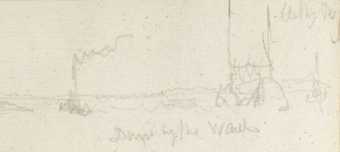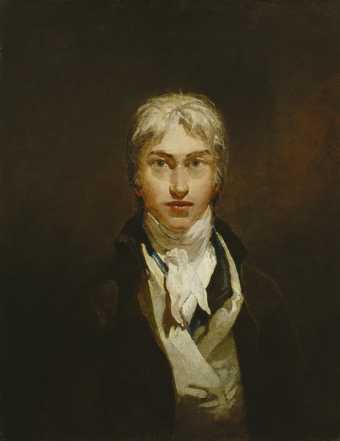
Fig.1
J.M.W. Turner
View of the Hofpoort in Rotterdam with the Blauwe Molen and St. Lawrence ?1833
Tate D32601
As a young boy, the artist J.M.W. Turner was intrigued by Dutch seventeenth-century paintings. According to an anecdote by Walter Thornbury, one of Turner’s earliest biographers, he might even have been inspired to become an artist by seeing a marine painting by Willem Van de Velde. Nevertheless, it was not until the late summer of 1817 that he travelled to the Netherlands, which then incorporated present-day Belgium, to admire the landscapes he had seen in the works of such painters as Aelbert Cuyp or Salomon van Ruysdael. Visiting the battlefield of Waterloo, south of Brussels, Turner travelled through the entire country, passing every significant town and recording hundreds of impressions of Dutch buildings, meadows and waters in four small pocket books. He returned to the country in 1825, filling one thick pocket book with his impressions and notes and a large horizontal book with more extensive views and detailed studies.
In all, ten sketchbooks in Tate’s collection of Turner’s sketchbooks contain drawings of Holland, of which six can be linked to his Dutch tours in 1817 or 1825. The other four were used during larger European tours. The port of Rotterdam was a commonly used starting point for British travellers, and Turner’s tours to Venice, Switzerland or Austria would occasionally start or end there as the river Rhine offered an easy journey landward. The books were once thought to have been used during Turner’s continental tours of the 1840s – to Venice in 1840 or Switzerland in 1841 and 1844 – but the 1835 Rotterdam sketchbook containing sketches of Rotterdam and its vicinity, has been identified by Turner scholar Cecilia Powell as used during a tour to Northern Germany, the Elbe, in which Turner headed back for England via Rotterdam.1

Fig.2
D. Moens
View of the Hofpoort in Rotterdam 1826
City Archives, Rotterdam
New research, however, suggests yet another earlier visit to the Netherlands. In the Rotterdam and Rhine sketchbook Turner drew places along the river Rhine, from Rotterdam south to Strasbourg. A number of drawings of Rotterdam show the Hofpoort, or gate, of the city, with a large column on top of it and the windmill known as ‘De Blauwe Molen’ nearby (figs.1 and 2). The gate was built in 1778 and pulled down in 1833. Another drawing in the book presents a view of the river Nieuwe Maas with a steam-ferry, commonly known as ‘Platluis’, that ran from 1828 and connected Rotterdam to the small town Katendrecht on the east of the city along the Nieuwe Maas. Turner’s note by the sketch, ‘Cathe Dreg’, supports the idea that the steamboat depicted is indeed the ‘Platluis’, as it can be seen as his attempt to render the name of the town Katendrecht (fig.3).

Fig.3
J.M.W. Turner
Down by the Waal ?1833
Tate D32609
The dating of the book, previously dated 1837–41, is thus narrowed down: the book must have been used between 1828, when the ‘Platluis’ was running between Katendrecht and Rotterdam, and 1833, when the Hofpoort was pulled down.
The only known continental trip by Turner in this period is a journey down the Danube to Vienna and Venice in the late summer of 1833. An Austrian newspaper recorded that Turner was in Innsbruck on 23 September that year on his way back to England. He travelled north and arrived in London by 20 October. The exact course of his return journey has not yet been established but the evidence of the Rotterdam and Rhine sketchbook makes it likely that Turner followed the Rhine northwards and left for England from the port of Rotterdam. The Rotterdam council decided to pull down the Hofpoort on 20 September and it must have been a matter of weeks before the gate was demolished. Turner thus might have made it to Rotterdam just in time to make his drawings of the odd-looking Hofpoort and its pillar in October 1833, at the end of his tour to Venice and before taking the ferry to England.


